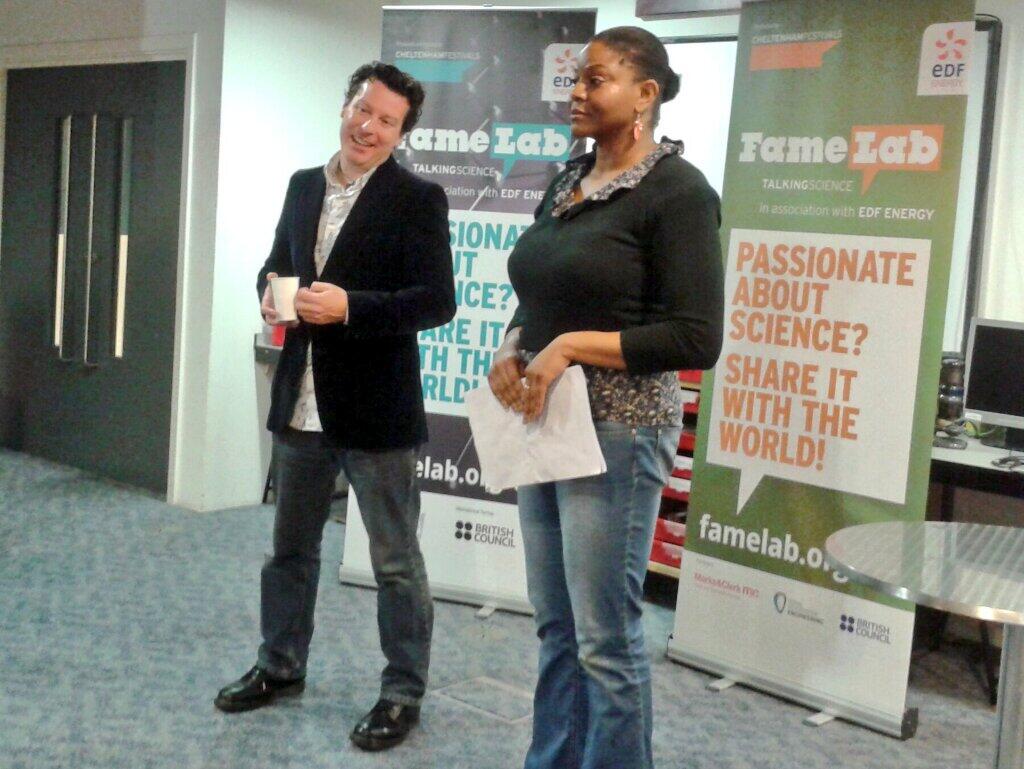Yesterday I was lucky enough to attend a masterclass run by Screenhouse (Barbara Govern @screenhouseprod, Paul Bader @paulbader, Victoria Pritchard @vic1redvoice ) and Dr. Maggie Aderin-Pocock. It was a really fun day and I left feeling inspired to take on any public speaking opportunity that comes my way!
After lunch we split into 3 groups and were immediately put in front of a camera! We had 60 seconds to talk about something we felt enthusiastic about, and then we watched all the tapes back afterwards. This was awful! No-one in my group enjoyed watching themselves back, even though we'd all done a pretty good job - maybe this is a general lack of self-esteem?
My group as a whole was encouraged to give the viewer time to think - we have an association between slow and calm speakers and authority, so embrace the full stops! It was also really interesting seeing the effect of facial expressions on the tone of your voice. It is very hard not to be mono-tonal when you are expressionless...
I was advised to relax my shoulders, allowing me to breathe more deeply. To practice this I was given two tennis balls to put in my armpits!
After two opportunities in front of the camera, we came together as one group and everyone got a chance to resent their 90 second piece to everyone. I loved this as the bigger the audience, the better, for me! It was great to see how everyone had improved, and the confidence level in the room was sky-high by the time we had all finished.
All-in-all, it was an excellent day - thanks to all the organisers and Maggie for speaking. I feel very encouraged and inspired ahead of next week's FameLab heat in Manchester - Bring It On!
The day began with us hearing from Maggie about her route into the media and what would await us if we chose to follow a similar path. She acted as an excellent role model, encouraging us to take opportunities rather than immediately passing questions on to someone more senior. They may not be a better communicator!
She then did a really interesting SWOT analysis of getting into TV presenting...
- Strengths include communicating your research out to a wider audience and getting your opinions heard. It can also be a great confidence booster!
- Weaknesses of time consumption and misquotations were mentioned, although the words "It's worth it" were mentioned a lot!
- Opportunities for female experts are appearing and being flexible about time and place but stubborn about content should allow you to use them.
- Threats to your career and social life were the key disadvantages, but support is out there (e.g. STFC fellowships) - make the most of it!
Paul Bader from Screenhouse then took over to give us an introduction on how to present our work in a media release. The difference between writing styles was highlighted: the formality, detailed and tentative nature of academia vs the definite but broad stories told by the media.
In general, a newspaper piece will tell the story 3 times:in the headline, the first paragraph and the conclusion. As with my writing course at ThinkTank last week, we were encouraged to take as many words out as possible - you should be able to summarise your story in one sentence.
We then split off into pairs to come up with a headline and a first paragraph describing our research. Quotes add personality and authenticity to a piece and it's useful if you prepare yours in advance of talking to a journalist.
After a lot of crossing out, I finally came up with a headline:
"Powders used to store hydrogen in vehicles prevent the need for high pressure tanks."and a quote:
"Currently, we use chemical hydrogen storage on a narrowboat here at the University of Birmingham, but the challenge is to make the system lighter for use in smaller vehicles such as cars"Next came a different kind of exercise - the tables were pushed to the side of the room and Victoria Pritchard took over. She wanted not to encourage us to be more confident, but for us to be ourselves, confidently. This means embracing personal traits like accents without becoming overly loud or enthusiastic. During the course of this session, you could see huge improvements made within the group.
After lunch we split into 3 groups and were immediately put in front of a camera! We had 60 seconds to talk about something we felt enthusiastic about, and then we watched all the tapes back afterwards. This was awful! No-one in my group enjoyed watching themselves back, even though we'd all done a pretty good job - maybe this is a general lack of self-esteem?
My group as a whole was encouraged to give the viewer time to think - we have an association between slow and calm speakers and authority, so embrace the full stops! It was also really interesting seeing the effect of facial expressions on the tone of your voice. It is very hard not to be mono-tonal when you are expressionless...
I was advised to relax my shoulders, allowing me to breathe more deeply. To practice this I was given two tennis balls to put in my armpits!
After two opportunities in front of the camera, we came together as one group and everyone got a chance to resent their 90 second piece to everyone. I loved this as the bigger the audience, the better, for me! It was great to see how everyone had improved, and the confidence level in the room was sky-high by the time we had all finished.
All-in-all, it was an excellent day - thanks to all the organisers and Maggie for speaking. I feel very encouraged and inspired ahead of next week's FameLab heat in Manchester - Bring It On!











